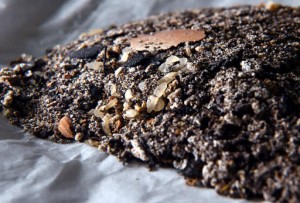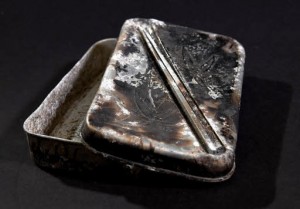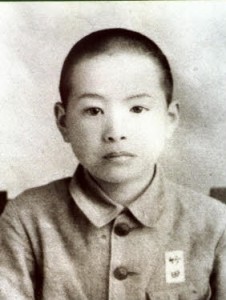Silent Witness: Lunchbox and a handful of earth, gathered by father of son who perished
May 14, 2018
by Miho Kuwajima, Staff Writer
A charred lunchbox, made of aluminum, has holes on its sides. It was donated to the museum, with the handful of earth inside it, by Shunji and Akiyoshi Takeda in 1995, the year that marked the 50th anniversary of the atomic bombing. The lunchbox belonged to Masaro Takeda, then a first-year student at Hiroshima Second Middle School (now Kanon High School). On the morning of August 6, 1945, Masaro was in the Nakajima district, near the bomb’s hypocenter, with classmates as they worked to tear down buildings. The atomic bomb exploded above his head and the heads of 320 schoolmates who had been mobilized for the war effort. They were engulfed by ferocious fire and were blown off their feet by the massive blast.
Shunji, Masaro’s father, who died in 2001 at the age of 97, left their home in the village of Neno in Hiroshima Prefecture (now the city of Aki-Takata) the next day to look for Masaro in the ruined city. He found Masaro’s lunchbox near the bank of the Honkawa River. He gathered up the earth around it, and placed this in the lunchbox to substitute for the remains of his son.
At the end of August, Shunji learned about Masaro’s last moments. Along with some schoolmates, Masaro had managed to reach a temple some distance away, but he died two days after the bombing. After that, Shunji never spoke about Masaro to anyone, not even to members of his own family. Masahiro, 72, a younger brother who was born one month after the war and now resides in Kobe, recalls, “When we tried to ask about Masaro, even just a little bit, he got angry.”
The lunchbox and the earth it contained were wrapped in newspaper and kept in the family’s storage room for many years. When Shunji grew old, his eldest son, Akiyoshi, who worked for the Chugoku Shimbun and died in 2011 at the age of 81, became concerned about the future and decided to donate these items to the museum.
Because the museum holds other lunchboxes from that time, Masaro’s lunchbox is not often put on display. His brother, Masahiro, who had been involved in peace activities in Hyogo Prefecture until two years ago, asked the museum to take the lunchbox out of storage and show it to those who wished to view it in August. “My brother suffered so much and died because of the atomic bombing when he was only twelve. None of the first-year students at Hiroshima Second Middle School survived, and hardly any of their personal effects were found. That’s what the atomic bombing did.” He wants people to understand the tragedy by showing Masaro’s lunchbox.
A stone tablet inscribed with a haiku (a type of Japanese poem) made by Masaro’s parents and dedicated to Masaro, stands beside the family tomb in Aki-Takata.
As your parents,
We didn’t do what parents were supposed to do,
Our dear child,
Now you are gone,
Please forgive us.
(Originally published on May 14, 2018)
A charred lunchbox, made of aluminum, has holes on its sides. It was donated to the museum, with the handful of earth inside it, by Shunji and Akiyoshi Takeda in 1995, the year that marked the 50th anniversary of the atomic bombing. The lunchbox belonged to Masaro Takeda, then a first-year student at Hiroshima Second Middle School (now Kanon High School). On the morning of August 6, 1945, Masaro was in the Nakajima district, near the bomb’s hypocenter, with classmates as they worked to tear down buildings. The atomic bomb exploded above his head and the heads of 320 schoolmates who had been mobilized for the war effort. They were engulfed by ferocious fire and were blown off their feet by the massive blast.
Shunji, Masaro’s father, who died in 2001 at the age of 97, left their home in the village of Neno in Hiroshima Prefecture (now the city of Aki-Takata) the next day to look for Masaro in the ruined city. He found Masaro’s lunchbox near the bank of the Honkawa River. He gathered up the earth around it, and placed this in the lunchbox to substitute for the remains of his son.
At the end of August, Shunji learned about Masaro’s last moments. Along with some schoolmates, Masaro had managed to reach a temple some distance away, but he died two days after the bombing. After that, Shunji never spoke about Masaro to anyone, not even to members of his own family. Masahiro, 72, a younger brother who was born one month after the war and now resides in Kobe, recalls, “When we tried to ask about Masaro, even just a little bit, he got angry.”
The lunchbox and the earth it contained were wrapped in newspaper and kept in the family’s storage room for many years. When Shunji grew old, his eldest son, Akiyoshi, who worked for the Chugoku Shimbun and died in 2011 at the age of 81, became concerned about the future and decided to donate these items to the museum.
Because the museum holds other lunchboxes from that time, Masaro’s lunchbox is not often put on display. His brother, Masahiro, who had been involved in peace activities in Hyogo Prefecture until two years ago, asked the museum to take the lunchbox out of storage and show it to those who wished to view it in August. “My brother suffered so much and died because of the atomic bombing when he was only twelve. None of the first-year students at Hiroshima Second Middle School survived, and hardly any of their personal effects were found. That’s what the atomic bombing did.” He wants people to understand the tragedy by showing Masaro’s lunchbox.
A stone tablet inscribed with a haiku (a type of Japanese poem) made by Masaro’s parents and dedicated to Masaro, stands beside the family tomb in Aki-Takata.
As your parents,
We didn’t do what parents were supposed to do,
Our dear child,
Now you are gone,
Please forgive us.
(Originally published on May 14, 2018)










